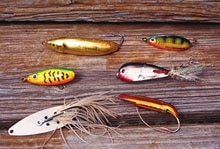
Fishing lures come in every conceivable size, shape and configuration, yet the simple spoon remains the most versatile ever designed. Spoons are available in hundreds of variations, but one size does not fit all. Some are designed for casting, others are made for trolling or jigging, and still more are built for fishing thick, weedy tangles and snags. Choose spoons based on the kind of water and depth to be fished and the desired lure speed and action to draw consistent strikes.
Most spoons are made of durable metal, though a few are made of heavy-duty plastic. Most are somewhat oval-shaped or long and rather slender with rounded edges. When retrieved, spoons are intended to represent baitfish, an important point for anglers to remember.
Spoons teeter during a retrieve because of their irregular shape. A quality spoon should wiggle, shake and shimmy at almost any retrieve speed regardless of the action (or lack of it) an angler imparts. A good spoon should have high-grade, easy-to-sharpen hooks and be durable enough to take repeated strikes from tough, toothy fish. Whether equipped with split rings or not, spoons should be rigged with a quality swivel in the main line to help avoid line twist. For toothy fish like mackerel and bluefish, short wire leaders with barrel swivels fitted between the wire and fishing line work well.
Prime Choice
Although almost any spoon can be fished from the surface to the bottom, the shape and weight of a spoon determine the right lure for the job. A broad, thin-bladed spoon sinks slowly with a wide, fluttering action. A thick, streamlined spoon falls quickly and is likely to have a tight, fast, side-to-side motion. Thus the shape and weight of a spoon determines the speed and depth in which the lure is best fished. For example, if it is necessary to work a spoon deep and fast, it’s best to use a compact, heavy-blade spoon, such as a Bomber Slab Spoon. These sink quickly into the strike zone and give the illusion of moving very fast because of their rapid side-to-side wobble.
Weedless spoons, such as the Johnson Silver Minnow and the Norton Brass Rattler, are popular because they enable anglers to work weeds without fouling hooks. Weed-guards on weedless spoons can make hooking fish difficult, so be extra careful to sharpen all weedless-spoon hooks properly.
Many veteran weedless-spoon fans rarely work such lures without the addition of a piece of porkrind, screw-tail plastic worm or a plastic skirt. Such trailers give a spoon outstanding extra action.
|| |—| || |Pick spoons according to the depth and habitat being fished.| Spoon-jigging is one of the most effective techniques for catching deep inshore fish, or those holding in strong current or tide flow. Most jigging spoons are long, thick and heavy so they sink like rocks, but they have great flashy action that mimics a dying or sick baitfish.
Vertical jigging with a spoon is effective when working deep water that’s difficult to fish via casting or even trolling. Jigging is also ideal when schools of fish appear on the fishfinder to be keying on structure. Most of the time a jigging spoon is simply allowed to fall to the bottom, then a lift-and-drop action is imparted to it. Most strikes come as a lure drops.
For most inshore fishing, spoons in brass, copper, silver, black and two-tone painted hues are serviceable. A good rule is to use bright spoons on sunny days and dark-colored spoons in low light.
Some anglers discard old spoons when the finish becomes tarnished or paint becomes dirty. Well-used spoons can be made like new by scrubbing them with a kitchen cleanser. If the paint on a spoon is chipped, remove it with steel wool, sandpaper or turpentine. Many spoons are shiny metal under the paint and still work even with the bright coloring removed.









